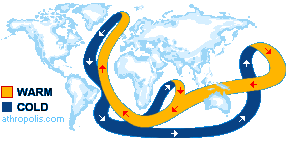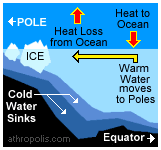
 Dense, cold water at the poles sinks and travels throughout the world's oceans. It gradually mixes with warmer water, becomes less dense, and rises to the surface - where it is warmed even more.
This water is replaced by warmer surface water, fueling the currents of the Great Ocean Conveyor Belt. Without this cycle, the poles would be colder and the equator would be warmer.
But global warming and retreating Arctic ice could give parts of North America and Western Europe a severe chill, possibly within a few decades. That may seem like an unusual statement - global warming causing colder conditions - but here's how it could happen. The thawing of Polar sea ice could disturb or even halt the currents in the world's oceans. Without the vast amounts of heat that these ocean currents deliver (comparable to the power generation of a million nuclear power plants), parts of eastern North America would cool down and Europe's average temperature would likely drop 5-10°C / 9-18°F. Such a drop in temperature would be similar to global average temperatures toward the end of the last ice age - roughly 20,000 years ago.
Click pictures for more information and credits. Library: Arctic, Land, Ice, Snow Environment/Atmosphere Links: Arctic, Ice Age, Environment Arctic Maps & Weather Reports |

|
DICTIONARY: Just "double-click" any unlinked word on this page for the definition from Merriam-Webster's Student Electronic Dictionary at Word Central. |

|
ARCTIC LIBRARY & GLOSSARY: Check this section for an index of the rest of the things you really need to know about the Arctic. |

|
ARCTIC MAPS & WEATHER REPORTS: Maps of the Northwest Passage, explorers' routes, iceberg sources, Nunavut, the Arctic by treeline, temperature... |

|
ARCTIC LINKS: Even more information! Links to sites related to the Arctic and "Iceberg: the Story of the Throps and the Squallhoots". |

|
GUIDE TO ARCTIC SUNRISE & SUNSET: How much sunlight or darkness is there in the Arctic on each day of the year? |
to is the property of their respective owners, and Athropolis is not responsible for their content.
